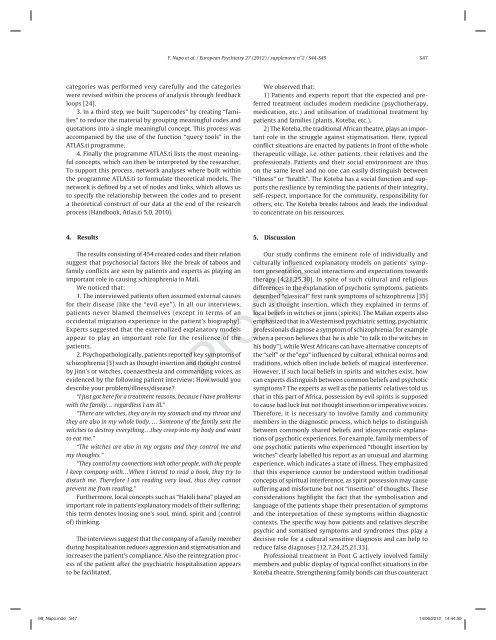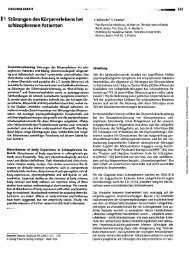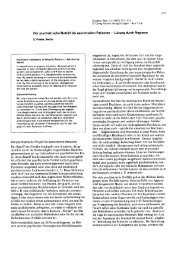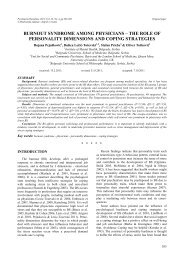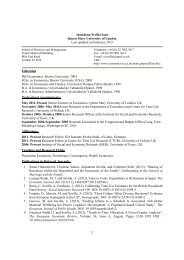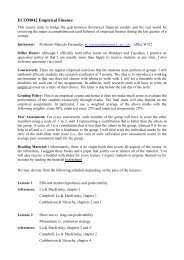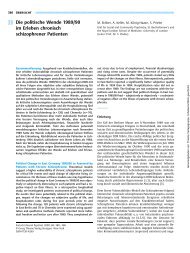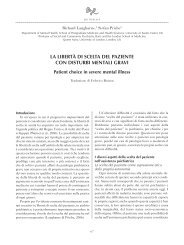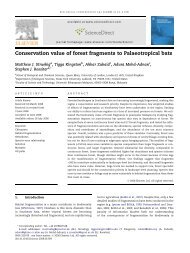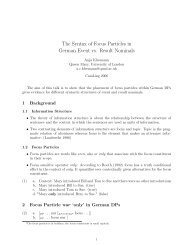Proofs - Personal Webspace for QMUL - Queen Mary, University of ...
Proofs - Personal Webspace for QMUL - Queen Mary, University of ...
Proofs - Personal Webspace for QMUL - Queen Mary, University of ...
Create successful ePaper yourself
Turn your PDF publications into a flip-book with our unique Google optimized e-Paper software.
categories was per<strong>for</strong>med very carefully and the categories<br />
were revised within the process <strong>of</strong> analysis through feedback<br />
loops [24].<br />
3. In a third step, we built “supercodes” by creating “families”<br />
to reduce the material by grouping meaningful codes and<br />
quotations into a single meaningful concept. This process was<br />
accompanied by the use <strong>of</strong> the function “query tools” in the<br />
ATLAS.ti programme.<br />
4. Finally the programme ATLAS.ti lists the most meaningful<br />
concepts, which can then be interpreted by the researcher.<br />
To support this process, network analyses where built within<br />
the programme ATLAS.ti to <strong>for</strong>mulate theoretical models. The<br />
network is defi ned by a set <strong>of</strong> nodes and links, which allows us<br />
to specify the relationship between the codes and to present<br />
a theoretical construct <strong>of</strong> our data at the end <strong>of</strong> the research<br />
process (Handbook, Atlas.ti 5.0, 2010).<br />
4. Results<br />
The results consisting <strong>of</strong> 454 created codes and their relation<br />
suggest that psychosocial factors like the break <strong>of</strong> taboos and<br />
family confl icts are seen by patients and experts as playing an<br />
important role in causing schizophrenia in Mali.<br />
We noticed that:<br />
1. The interviewed patients <strong>of</strong>ten assumed external causes<br />
<strong>for</strong> their disease (like the “evil eye”). In all our interviews,<br />
patients never blamed themselves (except in terms <strong>of</strong> an<br />
occidental migration experience in the patient’s biography).<br />
Experts suggested that the externalized explanatory models<br />
appear to play an important role <strong>for</strong> the resilience <strong>of</strong> the<br />
patients.<br />
2. Psychopathologically, patients reported key symptoms <strong>of</strong><br />
schizophrenia [3] such as thought insertion and thought control<br />
by jinn’s or witches, coenaesthesia and commanding voices, as<br />
evidenced by the following patient interview: How would you<br />
describe your problem/illness/disease?<br />
“I just got here <strong>for</strong> a treatment reasons, because I have problems<br />
with the family… regardless I am ill.”<br />
“There are witches, they are in my stomach and my throat and<br />
they are also in my whole body. … Someone <strong>of</strong> the family sent the<br />
witches to destroy everything…they creep into my body and want<br />
to eat me.”<br />
“The witches are also in my organs and they control me and<br />
my thoughts.”<br />
“They control my connections with other people, with the people<br />
I keep company with…When I intend to read a book, they try to<br />
disturb me. There<strong>for</strong>e I am reading very loud, thus they cannot<br />
prevent me from reading.”<br />
Furthermore, local concepts such as “Hakili bana” played an<br />
important role in patients’explanatory models <strong>of</strong> their suffering;<br />
this term denotes loosing one’s soul, mind, spirit and (control<br />
<strong>of</strong>) thinking.<br />
The interviews suggest that the company <strong>of</strong> a family member<br />
during hospitalisation reduces aggression and stigmatisation and<br />
increases the patient’s compliance. Also the reintegration process<br />
<strong>of</strong> the patient after the psychiatric hospitalisation appears<br />
to be facilitated.<br />
F. Napo et al. / European Psychiatry 27 (2012) / supplement n°2 / S44-S49 S47<br />
We observed that:<br />
1) Patients and experts report that the expected and preferred<br />
treatment includes modern medicine (psychotherapy,<br />
medication, etc.) and utilisation <strong>of</strong> traditional treatment by<br />
patients and families (plants, Koteba, etc.).<br />
2) The Koteba, the traditional African theatre, plays an important<br />
role in the struggle against stigmatisation. Here, typical<br />
confl ict situations are enacted by patients in front <strong>of</strong> the whole<br />
therapeutic village, i.e. other patients, their relatives and the<br />
pr<strong>of</strong>essionals. Patients and their social environment are thus<br />
on the same level and no one can easily distinguish between<br />
“illness” or “health”. The Koteba has a social function and supports<br />
the resilience by reminding the patients <strong>of</strong> their integrity,<br />
self- respect, importance <strong>for</strong> the community, responsibility <strong>for</strong><br />
others, etc. The Koteba breaks taboos and leads the individual<br />
to concentrate on his ressources.<br />
5. Discussion<br />
Our study confi rms the eminent role <strong>of</strong> individually and<br />
culturally infl uenced explanatory models on patients’ symptom<br />
presentation, social interactions and expectations towards<br />
therapy [4,21,25,30]. In spite <strong>of</strong> such cultural and religious<br />
differences in the explanation <strong>of</strong> psychotic symptoms, patients<br />
described “classical” fi rst rank symptoms <strong>of</strong> schizophrenia [35]<br />
such as thought insertion, which they explained in terms <strong>of</strong><br />
local beliefs in witches or jinns (spirits). The Malian experts also<br />
emphasized that in a Westernised psychiatric setting, psychiatric<br />
pr<strong>of</strong>essionals diagnose a symptom <strong>of</strong> schizophrenia (<strong>for</strong> example<br />
when a person believes that he is able “to talk to the witches in<br />
his body”), while West Africans can have alternative concepts <strong>of</strong><br />
the “self” or the”ego” infl uenced by cultural, ethnical norms and<br />
traditions, which <strong>of</strong>ten include beliefs <strong>of</strong> magical interference.<br />
However, if such local beliefs in spirits and witches exist, how<br />
can experts distinguish between common beliefs and psychotic<br />
symptoms? The experts as well as the patients’ relatives told us<br />
that in this part <strong>of</strong> Africa, possession by evil spirits is supposed<br />
to cause bad luck but not thought insertion or imperative voices.<br />
There<strong>for</strong>e, it is necessary to involve family and community<br />
members in the diagnostic process, which helps to distinguish<br />
between commonly shared beliefs and idiosyncratic explanations<br />
<strong>of</strong> psychotic experiences. For example, family members <strong>of</strong><br />
one psychotic patients who experienced “thought insertion by<br />
witches” clearly labelled his report as an unusual and alarming<br />
experience, which indicates a state <strong>of</strong> illness. They emphasized<br />
that this experience cannot be understood within traditional<br />
concepts <strong>of</strong> spiritual interference, as spirit possession may cause<br />
suffering and mis<strong>for</strong>tune but not “insertion” <strong>of</strong> thoughts. These<br />
considerations highlight the fact that the symbolisation and<br />
language <strong>of</strong> the patients shape their presentation <strong>of</strong> symptoms<br />
and the interpretation <strong>of</strong> these symptoms within diagnostic<br />
contexts. The specifi c way how patients and relatives describe<br />
psychic and somatised symptoms and syndromes thus play a<br />
decisive role <strong>for</strong> a cultural sensitive diagnosis and can help to<br />
reduce false diagnoses [12,7,24,25,21,33].<br />
Pr<strong>of</strong>essional treatment in Pont G actively involved family<br />
members and public display <strong>of</strong> typical confl ict situations in the<br />
Koteba theatre. Strengthening family bonds can thus counteract<br />
<strong>Pro<strong>of</strong>s</strong><br />
08_Napo.indd S47 14/06/2012 14:44:50


